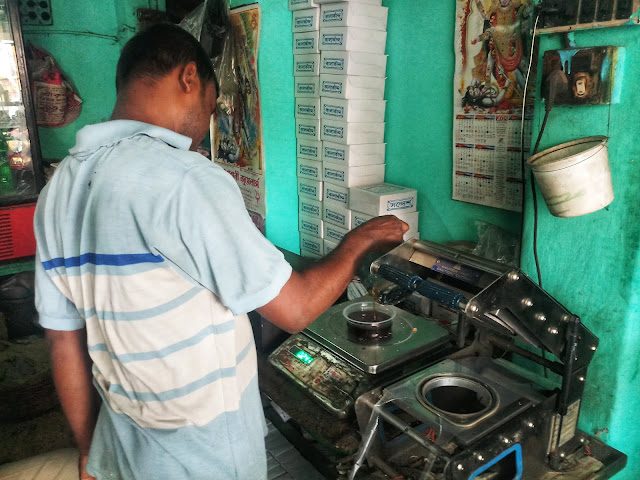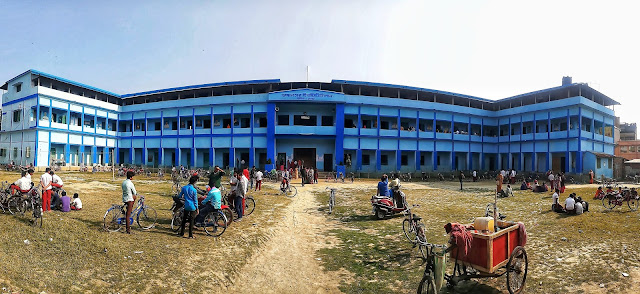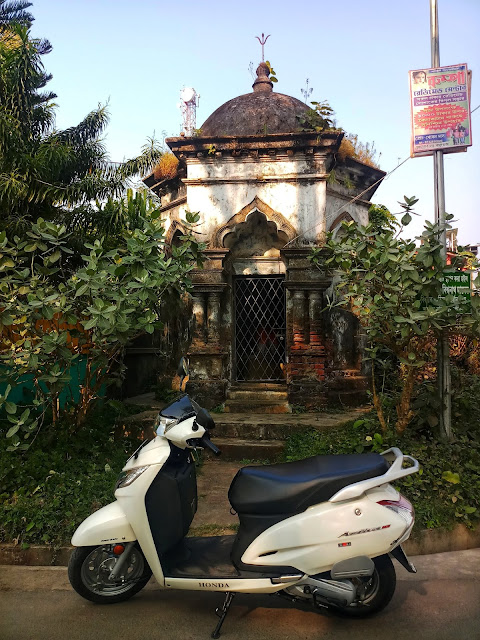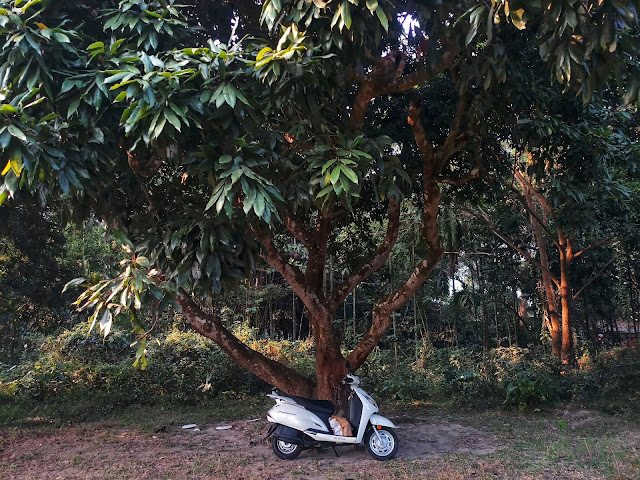Joynagar is just another small hamlet like a million others,
tucked away somewhere in the depths of the District of South 24 Parganas in
West Bengal. But there is a difference, Joynagar is almost a household name,
not only in Bengal but outside too and the reason of course is finest quality
of Moa or Moya that is produced here. It is not the sole example though where a
place is known by the food it produces and for Bengal it had been no exception.
The interesting part is more than anything else most of such places have been
associated with some kind of sweets that is produced locally and I am not
surprised when the WB Tourism department decided to use the tagline “The
sweetest part of India”. The list is quite long, Sitabhog and Mihidana
from Burdwan, Lyancha at Shaktigarh, Pantua at Ranaghat, Sarpuria and Sarbhaja
from Krishnanagar, Lal Doi from Nabadwip, Monohara at Janai, Babarsha at
Khirpai, Mecha Sandesh of Beliatore, Makha Sandesh of Guptipara, Lal Doi of
Nabadwip, the unique Jhuri Doi a
nd Chanabara from Baharampur, the list is long
and elaborate and I haven’t even added all.
So what’s so unique
about Joynagarer Moa?
Joynagar of-course is all about Moa, and in fact both words are
uttered in same breath. It's not just Moa but “Joynagarer Moa” as said in
Bengali and come winter thousands of sweet shops in Kolkata and districts start
flaunting “Joynagarer Moa” available on sign boards and flexes. Interestingly
most of these Moa on sale are not even from Joynagar, but made somewhere
else, often locally. But you can’t really sell Moa without calling it
“Joynagarer Moa” and that’s the order of the day.
This precisely is the reason I prefer to buy Moa from
Joynagar only. The authenticity part is taken care of and that also gave
me a chance to be a witness to the elaborate process that goes on behind for
making the finest Moa. Making good quality Moa requires lot of skill and
experience and the people who make are truly artisans per excellence. But then
this could be replicated anywhere else. Then what’s so special about Joynagar?
That’s the question that first came to my mind a couple of years back when I
had started expanding my interest beyond savoring the Moa and dug into
the fascinating process that goes into making it. The primary components are
"Khoi" (puffed rice) “Nolen Gur” or the date palm jaggery, the edible
liquid gold which are napped into Ghee (clarified butter). Then Khowa Kheer,
dry grapes, pistachio crumbs, cardamom and cashew nuts are added as taste
enhancer and garnishing. The secret lies in the milky white Khoi, which comes
from only a breed of paddy called “Kanakchur” which is extensively cultivated
around Joynagar block and surrounding areas and not anywhere else in Bengal or
outside. This is what makes Moa unique to Joynagar and Moa has also earned the
Geographical Indication (GI) tag. The notification covers the Block I and II of
Joynagar Majilpur Municipal area.
Anyways I will not delve much into the technicalities as that is
not the purpose of this post. I had documented my findings and experience in my
blogpost in full details and anybody interested can check this out from the
link below.
Story about Joynagar Moa and Nolen Gur
Story about Joynagar Moa and Nolen Gur
Come winter and I have made it a ritual for myself to make a trip to Joynagar to pick up Moa and some fine Nolen Gur. This year was no exception and I made the season’s first visit as the chill set in. This year I wanted to make this a short riding trip and in addition to Moa and Gur I intended to find out what else Joynagar has on offer and I must say I wasn’t disappointed. Though the Moa had taken the center stage and overshadowed everything else, still Joynagar can garner interest in anyone’s mind with it’s history, culture and temples.
This time I decided to leave the Dominar behind. I had to carry
back a lot of precious load which the motorcycle was not suitable for. So it
was my trusted Honda Activa 125 , that was chosen for the job. Scooters are made to
run errands and handle daily chores rather than touring but they can be a
perfect companion even on a longish trip. A scooter wouldn’t travel fast
thereby automatically allowing me to enjoy the surroundings and soak in the
scenery without taking away too much concentration for the ride alone.
So on a fine chilly morning, I set off from home, with the small
5.3 liter tank filled to the brim. Joynagar was approximately 65kms away from
my home hence the round trip could easily be done without the need to refill.
From my New Town home I took the EM Bypass and went all through the length of
the road terminating past Garia at the flyover which leads to the newly built
bypass leading to Baruipur. This is beautiful road with the up and down
corridor running parallel to both sides of the banks of a canal which acts as
divider. There is still lot of greenery and tree cover around but the fast
paced construction of huge housing projects on both sides of the road shall
ensure that the road will lose it’s charm is near future. Thankfully now
it was devoid of much traffic and joy to ride on. The surfacing is good enough
as not to pose any problem for the Activa
 |
The Honda Activa 125 en route to Joynagar |
I took the turn and then in few minutes later I was riding into
the countryside. The single lane road, at places was quite busy with buses,
trucks and autorickshaws. The road would occasionally pass by congested
marketplaces, but going was good. The engine of the Activa pulling effortlessly
and I was easily keeping up with the rest of the traffic. The traction from the
automatic transmission was strong and linear, as if being pulled by an electric
motor. Quick overtaking of the slow moving engine vans and autorickshaws were
done with ease and the nimble handling of the scooter helped. I was thoroughly
enjoying the ride. Though there were some rough patches, but the Activa took
everything in it’s stride and marched on. Places with sweet sounding names like
Krishnamohon, Gocharon, Padmer hat, Dakshin Barasat, passed by. Finally I was
at Bohoru, just few kilometers ahead of Joynagar. This is where the land of Moa
starts. Interestingly Bohoru is also famous for it’s Moa though the magnitude
of popularity is far less when compared to Joynagar. However the locals are
proud of their Moa which they claim to be distinctly different in flavor and
taste from Joynagar. In fact earlier I noticed a strong undercurrent towards
battle of supremacy between the two places, each claiming their’s are the best.
Well I have tasted both, from the best of the shops where they offered Moa of
highest quality to me. All I can say both are equally good with Joynagar’s moa
bearing a comparatively subtle taste. Maybe I am biased that wee bit towards
Joynagar. People may disagree as this is something strongly personal.
The hordes of shops on both sides of roads started showing up as
I entered Bohoru. Colorful flexes in bright yellow and red screamed of best
quality "Bohorur Moa" and gur. Interestingly most of the shops are
temporary. There are shops which were originally selling hardware, stationery
items etc. Some are makeshift ones, but come winter everything turns into a Moa
shop to cash in on the frenzy. Moa is cottage industry here, made at many
homes, so there is no dearth of supply but the quality is often questionable.
So it is better to stick to the old sweet shops who have been making good Moa
since ages. One of my favorite is Shyamsundar Mishtanna Bhadar which is a good
option for buying the famous Bohoru Moa.
However this time picking up Moa from Bohoru wasn’t on my cards. I would have passed by, but I stopped to see the imposing structure of
Bohoru High School right on the road. It is a rather staid building, devoid of
any architectural charm. Just that it is a huge boxy building, painted in
bright white color with blue stripes as is the norm in Bengal these days.
However the Bas-Relief concrete lettering on the main gate announce the name of
the school and year of establishment which is 1856, which means a year before
Sepoy Mutiny. This locality existed back then and for a moment I tried to shut
my eyes and think how this very place would have looked like in those times . I
am sure this was also part of the Sundarban biosphere back then as the mangrove
forest had retracted since human habitation expanded and engulfed a sizable
part of the forest. The school could have been a single room back then, may be
just a mud house, who knows. Looking at the huge building brimming with
students this seemed so unreal.
The different blocks of the building are dedicated and named
after famous people like Dr. Nilratan Sarkar, Poet Shakti Chattopadhyay and
singer Hemanto Mukherjee, or Hemant Kumar as he was known in Bollywood, whose
ancestral home was here.
Then I rode the short distance to Joynagar. From here onwards,
the road is congested as it passes through crowded marketplace. I had to
carefully negotiate the Activa through a tangle of motorized vans,
auto-rickshaws and occasional trucks. I rode upto Joynagar railway station
where my day’s destination was.
Shrikrisha Mistanna Bhandar is located right on the T junction
where the road connecting the Joynagar railway station meets the main road I
was travelling on. This was marked as SH 1. The shop is quite prominent and location
is such you can’t miss it. I squeezed the scooter in the narrow space between
the shop and the shoulder of the road, which is another virtue of being a
scooter. Parking a car is simply out of question here. I couldn't have
parked my Dominar the way I parked the Activa.
This is one of the oldest shop in Joynagar started by two
friends Purna Chandra Ghosh and Nitya Gopal Sarkar back in the year1929. To the
locals, this is also known as “Bunchki Babur dokan” as Nitya Gopal was known
more by his pet name Bunchki. The shop is small non-descript and not received
much upgrades and decor since it’s humble beginning. It’s still a dingy
old joint but churns out some amazing Moa and Nolen Gur.Now this is being
managed by Ashok Ghosh, son of Purna Chandra Ghosh. This year the best quality
Moa is retailing for Rs.350/- a kilo and Nolen Gur at Rs.160/- a kilo.
They also have a lesser variety of Moa at Rs.250/- per kilo but coming all the
distance I wanted nothing but the best. I placed my order then went out to
explore the place, something which I didn’t do before.
 |
Moa at Shrikrishna Mishtanna Bhandar |
 |
The Nolen Gur at Srikrishna Mishtanna Bhardar is of excellent quality |
 |
Nolen Gur being packed at Shrikrishna Mishtanna Bhandar |
I had also heard that Joynagar had few old temples. I decided to
explore them next. The SH 1 cuts through the city. Coming from Kolkata the
railway track will be on left and the main city extends on the right side.
There are large water bodies on both sides of the road often obscured by the
row of buildings and shops. Through gaps I could see the water body and forms
of some temples on the opposite side. At one place there is a ghat. I stopped
the scooter and went down. As I stepped down the ghat, the row of white temples
were clearly visible on the other side with their reflection on the water. I
came up and then rode through a narrow lane running from state highway into the
main locality. I asked around the locals and was told that there are two
temples which should interest me. The first one was the Joychandi Temple, which
is apparently an incarnation of Goddess Durga. It is said that the name
Joynagar was derived from Devi Joychandi. The second one was the 12 Shiva Temples.
Both the temples were close by and I asked my way around from
the locals. None of the temples are too far away from the road running parallel
to the state highway. As I started riding, a pair of temples first caught my
eyes. Both have been painted in white. One is in typical Atchala construction
and the other looked like a ‘Dolmancha, set on a square base with
“Charchala Construction” on top with four arched gateways on four sides. Nobody
could throw light on these temples as to how old they are or anything about
their history. The Atchala temple has rather simple construction with no ornate
front facade or walls.
A short distance away at one corner I saw another small temple
with domed top and entrance with three foiled cusped arch and double pillars on
both sides. Somehow I felt that this has strong influence of Islamic
architecture. This was a shiva temple and it is evident that regular worshiping is conducted here. Again I could not find anybody who could tell me
the details of this small but rather unique temple.
Moving on, just a short distance away I asked the locals again
and entered a narrow lane on my left which led to the Joychandi Temple.
Situated on a large ground, this is a “Dalan” type architecture and entrance
with three arches and square pillars. An expansive, fully shaded and cemented
pavilion or ‘Natmandir’ adorns the front of the temple for the devotees to
gather. The idol is small, standing on a lotus seat with two hands visible. The
left hand is in ‘Barabhoy’ mudra. Agains there was nobody, not even a priest
whom I could ask for the details and the history of the temple.
Moving on I again rode out on the main road which led straight to the 12 Shiva temples. Beautifully located with large water bodies in front, the temples are quite impressive. The positioning of the water-bodies indicate that at one point of time a river flowed here. Long back the river chaged course leaving its trace only in the form of elongated and separated water-bodies in a line. I am not sure if it was Ganges or one of it’s tributaries but existence of a river is easily identifiable.
All the temples are Atchala constructions barring one which was
constructed in Pancharatna Style. The front fascia for all temples are
beautiful with elaborate arched entrances where twin pillars are adorning both
sides of the door. There isn’t much of terracora work found on any of the
temples. The temples are all painted in bright white and in stark contrast
there is a twin pillared doorway in between the 12 temples, painted in bright
red. The road passing through went into the neighborhood inside. In addition
to the 12 temples there is a large Dolmancha on one side. The marble plaque
read that this was built by Ramkanai Basu in the Bengali year of 1205.which
means the Dolmancha is about 220 years old.
From the look of it, I think these temples were painted in white
in recent times. I am not sure if terracotta panels existed on these temples
but even if they were now its all gone. The typical look of brick and
terracotta temple is missing but what remains is still interesting.
Legend has it that in 1600 AD when King Pratapaditya Roy of
Jessore, the last independent Hindu king of Bengal, lost battle against the
Mughals, his dewans, and priests fled to avoid possible death or conversion.
They came to this place with the deity of Radha Krishna and settled down. A
Brahmin named Shree Krishna Udgata settled here at a place known today as
‘Bhattacharjee Para’. The present residents, the Bhattachariyas, are all his
scions. Currently the temple complex is maintained by "Mitraganga
Trust" as evidenced from the plaques. They also maintain the ghats along
the water bodies.
This was enriching experience barring the fact that I could
learn almost nothing about the rich history of the place and the temples. May
be I will have to search for appropriate books and references and try to
unearth the details.
I rode back to the shop, collected the full load of Moa and
Nolen gur, settled the bill and started my return journey by the same route.
Somewhere near Gocharon, on my left I saw a narrow road leading inside a
foresty patch. It was a beautiful afternoon and the road seemed worth
exploring. So I went in. After about 100 meters the condition worsened and it
almost turned into a dirt track. The Activa handled that bit of off-roading and
trundled on. The scenery was beautiful around me. On both sides of the trail I
could see fields full with blooming cauliflowers. Tall betel nut trees lined
the borders of the field, their leaves shining under the golden afternoon sun.
It was almost surreal inside. Further down I noticed a mango grove, with leafy
branches spread out wide and rays of sunlight casting patterns of light and
shadow on the grassy ground. It was so calm inside, almost devoid of any noise.
I parked the scooter, settled on a branch and lit a cigarette. These are the
precious moments of life, a perfectly earned “me time” on a road-trip.
Few minutes later I started back. Further down, while I was
riding on the extended EM Bypass I had stopped by at a small restaurant as I
was longing for a hot cup of tea. Restaurant would be an exaggeration to
describe the place. It is a rustic joint with a nice touch. The location was
nice. This was on a deserted stretch of road. The shop had an open area in front
with shade where the seating arrangements are made. This looked just the place
where you feel like taking a short break, strecting your legs during a drive /
ride and have a quick adda session over tea and snacks. The tables are actually
the wooden rollers used to store cables, nice touch again. The two brothers
running the shop are nice people and ready to strike up a conversation with
anybody walking in. Before tea I ordered Maggi which was made with eggs and
tasted good. They also sell meal on thali system, both of veg and non-veg
variety and it appeared that most of his customers are the medical
representatives and travelling salesmen. Must say I need to come back some day
for the rice thali. The ambiance and the nice company of the two brothers are good
enough reasons for a repeat visit.
It was an uneventful journey back home battling the usual late evening traffic on EM By-pass. When the pulled the scooter up the stand at home, the odo read 132KMs. A nice short day tour and I loved the way the scooter behaved all through. So more such scooter trips on the cards for me in coming days.























Such details and tenderly described locales! I admire your inquisitiveness too, my friend. Well done. Prithvijit
ReplyDeleteWar and History
ReplyDeleteReally Good Work Done By You...However, stopping by with great quality writing, it's hard to see any good blog today.
ReplyDeleteProcrackerPC
cracksoftwarefreedownload.com
Anni Crack
WinX HD Video Converter Deluxe CRACK
SaUL
ReplyDeletesaUlSaHAz
ReplyDeleteI love how you described the unique process behind making Joynagarer Moa.
ReplyDelete